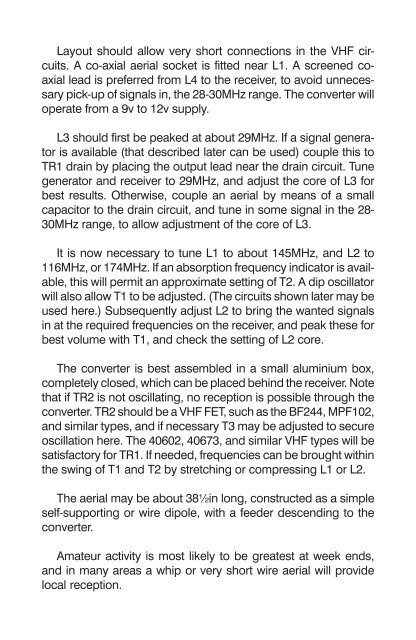50 (FET) Field Effect Transistor Projects - Battery Portable
50 (FET) Field Effect Transistor Projects - Battery Portable
50 (FET) Field Effect Transistor Projects - Battery Portable
- No tags were found...
Create successful ePaper yourself
Turn your PDF publications into a flip-book with our unique Google optimized e-Paper software.
Layout should allow very short connections in the VHF circuits.A co-axial aerial socket is fitted near L1. A screened coaxiallead is preferred from L4 to the receiver, to avoid unnecessarypick-up of signals in, the 28-30MHz range. The converter willoperate from a 9v to 12v supply.L3 should first be peaked at about 29MHz. If a signal generatoris available (that described later can be used) couple this toTR1 drain by placing the output lead near the drain circuit. Tunegenerator and receiver to 29MHz, and adjust the core of L3 forbest results. Otherwise, couple an aerial by means of a smallcapacitor to the drain circuit, and tune in some signal in the 28-30MHz range, to allow adjustment of the core of L3.It is now necessary to tune L1 to about 145MHz, and L2 to116MHz, or 174MHz. If an absorption frequency indicator is available,this will permit an approximate setting of T2. A dip oscillatorwill also allow T1 to be adjusted. (The circuits shown later may beused here.) Subsequently adjust L2 to bring the wanted signalsin at the required frequencies on the receiver, and peak these forbest volume with T1, and check the setting of L2 core.The converter is best assembled in a small aluminium box,completely closed, which can be placed behind the receiver. Notethat if TR2 is not oscillating, no reception is possible through theconverter. TR2 should be a VHF <strong>FET</strong>, such as the BF244, MPF102,and similar types, and if necessary T3 may be adjusted to secureoscillation here. The 40602, 40673, and similar VHF types will besatisfactory for TR1. If needed, frequencies can be brought withinthe swing of T1 and T2 by stretching or compressing L1 or L2.The aerial may be about 38½in long, constructed as a simpleself-supporting or wire dipole, with a feeder descending to theconverter.Amateur activity is most likely to be greatest at week ends,and in many areas a whip or very short wire aerial will providelocal reception.

















